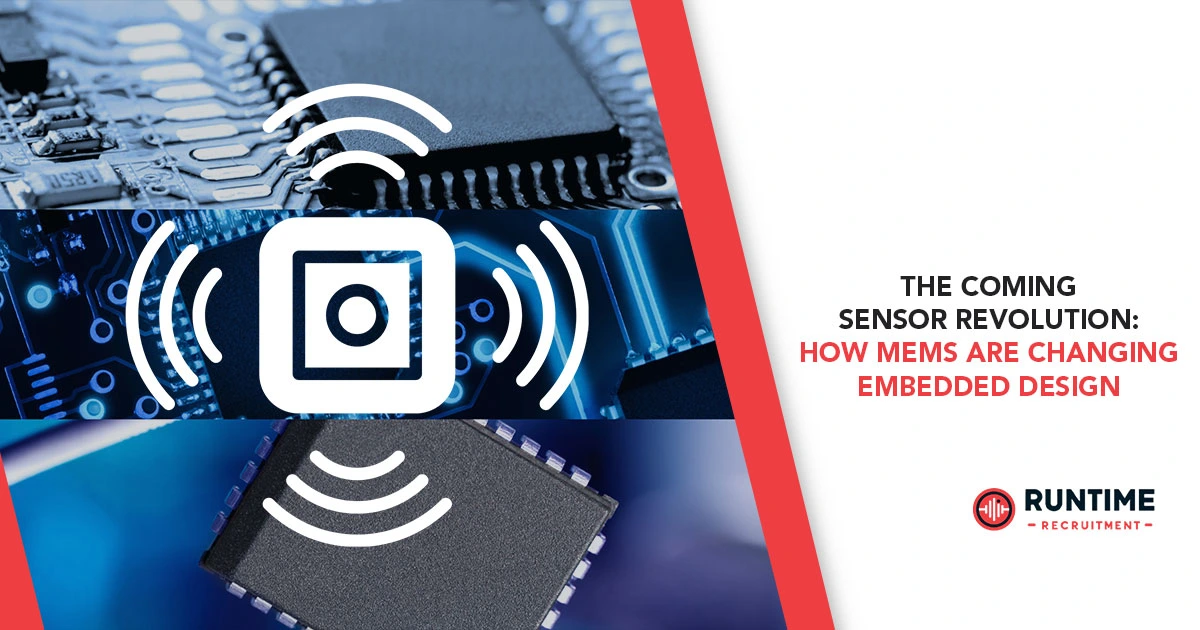Embedded engineers, we’re living in a world of unprecedented change. The devices we design are no longer isolated, single-function boxes. They are becoming intelligent, connected, and context-aware. This transformation isn’t just about faster processors or bigger memories; it’s being driven by a quiet revolution happening at the microscopic level. The revolution of Micro-Electro-Mechanical Systems, or MEMS.
For decades, sensors were a necessary evil. Clunky, analog, and often external to the core control circuitry, they were a design constraint. They consumed power, took up valuable board space, and often required complex signal conditioning. But today, a new generation of MEMS sensors is shattering these limitations. These tiny marvels, fabricated using techniques similar to those used for integrated circuits (ICs), are redefining what’s possible in embedded design. They are the eyes, ears, and sense of touch of the modern embedded world, and they’re fundamentally changing our approach to system architecture, power management, and application development.
From Macro to Micro: The MEMS Paradigm Shift
The core concept of a MEMS device is brilliantly simple: it integrates mechanical elements, sensors, actuators, and electronics on a single silicon chip. This marriage of mechanical and electrical engineering at the microscale is what gives MEMS their immense power. Imagine a miniature tuning fork, a tiny cantilever, or a movable proof mass, all etched onto a wafer of silicon. These mechanical structures are designed to respond to physical stimuli like motion, pressure, or temperature. The clever part is that the device also includes the electronic circuitry to convert these physical changes into a usable electrical signal, all within the same package.
This is a stark contrast to the old way of doing things. Traditional sensors were often bulky, required manual assembly, and were prone to mechanical failures. A MEMS accelerometer, for example, replaced a complex assembly of springs, masses, and electrical components with a single, highly-reliable silicon chip. This isn’t just a size reduction; it’s a fundamental shift in design philosophy. We’re no longer thinking about a sensor as a separate, external component. We’re thinking of it as an integrated, intelligent building block, a crucial part of a cohesive system-on-chip (SoC) design.
The Key Advantages of MEMS for Embedded Engineers
So, why should this microscopic revolution matter to you, the embedded engineer? The benefits of MEMS technology are far-reaching and directly impact the challenges you face every day.
1. Miniaturization and Integration
This is the most obvious and perhaps most impactful benefit. The tiny footprint of MEMS sensors allows for their integration into devices where space is at an absolute premium. Think of the accelerometer in your smartphone that reorients the display, the gyroscope in a drone that stabilizes its flight, or the pressure sensor in a medical wearable that monitors a patient’s vitals. These applications would be impossible without MEMS. This miniaturization also allows for the creation of multi-sensor packages, like 6- or 9-axis Inertial Measurement Units (IMUs) that combine accelerometers, gyroscopes, and magnetometers into a single, compact device. This simplifies PCB design, reduces component count, and lowers the bill of materials.
2. Power Efficiency
For battery-powered devices, power consumption is a primary design constraint. MEMS sensors are inherently more power-efficient than their traditional counterparts. Their microscopic scale means the mechanical elements have very little mass, requiring minimal energy to move and respond. Furthermore, the on-chip electronics can be designed for ultra-low power consumption, with some devices featuring low-power modes and event-based wake-up capabilities. This enables devices to run for extended periods on small batteries, a critical requirement for IoT devices and wearables.
3. Enhanced Performance and Reliability
MEMS sensors are not just smaller; they’re often better. Because they are fabricated using highly controlled semiconductor processes, they offer superior accuracy, repeatability, and long-term stability. The same batch-fabrication techniques that ensure the consistency of ICs also guarantee the consistency of MEMS sensors. They are also mechanically robust and can withstand shocks and vibrations that would destroy older, more fragile sensor types. This is essential for applications in harsh environments, from industrial automation to automotive systems. The on-chip digital signal processing (DSP) and calibration data in modern MEMS devices also contribute to their high performance, compensating for temperature drift and other environmental factors.
A World of New Possibilities
The MEMS revolution is not just about improving existing products; it’s about enabling a new generation of applications that were previously the stuff of science fiction.
In the Consumer Electronics Sphere: Beyond the well-known accelerometers and gyroscopes in smartphones, MEMS are driving innovation in countless areas. MEMS microphones, with their high signal-to-noise ratio and small size, are enabling advanced voice control and noise cancellation in everything from earbuds to smart speakers. MEMS pressure sensors are used in wearables to track altitude for fitness applications and in smartphones for barometric pressure readings that improve GPS accuracy.
The Automotive Industry: MEMS are now indispensable in modern vehicles. They are at the heart of airbag deployment systems, electronic stability control (ESC), and tire pressure monitoring systems (TPMS). The next wave will see MEMS sensors playing a critical role in autonomous vehicles, providing crucial data for navigation and environmental perception, complementing technologies like LiDAR and radar.
The Industrial and IoT Landscape: The Industrial Internet of Things (IIoT) is a massive growth area for MEMS. Predictive maintenance, a key tenet of Industry 4.0, relies on MEMS accelerometers to monitor vibration in machinery, detecting early signs of failure. Gas and chemical sensors are being used for air quality monitoring and process control. MEMS-based pressure and flow sensors are enabling more efficient and precise control in countless industrial processes. The rise of edge AI is making MEMS even more powerful, as data from these tiny sensors can be processed locally, reducing latency and bandwidth requirements.
Medical and Healthcare: In the medical field, MEMS are enabling the development of smaller, less invasive, and more comfortable devices. Pressure sensors are used in catheters and implantable devices. MEMS biosensors are being developed for point-of-care diagnostics and continuous health monitoring. The ability to create tiny, high-precision devices is paving the way for a new era of personalized medicine.
The Embedded Engineer’s New Skill Set
This sensor revolution isn’t just a new technology to plug in; it’s a new way of thinking. For embedded engineers, it requires an expanded skill set that goes beyond traditional microcontroller programming. You need to understand:
- Sensor Fusion: Combining data from multiple MEMS sensors (e.g., an accelerometer, gyroscope, and magnetometer) to create a more accurate and stable picture of a device’s orientation and motion. Algorithms like the Kalman filter are becoming essential tools in the embedded engineer’s arsenal.
- Digital Interfaces: The era of simple analog sensor outputs is fading. Modern MEMS sensors are almost exclusively digital, communicating over protocols like I2C and SPI. You need to be proficient in these protocols to correctly configure and read data from these devices.
- Low-Power Design: With MEMS enabling the rise of battery-powered IoT devices, optimizing for power consumption is no longer a luxury but a necessity. This includes mastering techniques like dynamic voltage and frequency scaling, using low-power standby modes, and implementing smart interrupt-driven designs.
- Hardware and Software Co-design: The tight integration of mechanical and electrical components on a MEMS chip means that hardware and software design are more intertwined than ever. You must consider the physical constraints and characteristics of the sensor when writing your code, and you must be able to debug issues that could be caused by either the physical world or the digital one.
The world of embedded systems is becoming more complex, but it’s also becoming more exciting. The MEMS revolution is putting powerful, intelligent sensing capabilities in our hands, opening up a universe of design possibilities.
The embedded design landscape is evolving at a breakneck pace, and the skills required to stay ahead are changing with it. As we move towards a future where every device is a connected, intelligent system, the ability to work with advanced MEMS and other sensor technologies will be a key differentiator. The demand for engineers who are not only proficient in traditional embedded systems but also masters of this new sensor-driven paradigm is exploding.
If you’re an embedded engineer looking to navigate this exciting new world, now is the time to invest in your career. The skills you have today are valuable, but the skills you will need tomorrow are what will truly set you apart.
Are you ready to join the revolution?
Connect with RunTime Recruitment
At RunTime Recruitment, we understand the unique and specialized needs of the embedded engineering market. We’re connected to the leading companies and the most innovative projects in the industry, and we know exactly what skills are in high demand. Whether you’re a seasoned professional looking for your next challenge or a new graduate eager to make your mark, we can help you find the perfect role.
Ready to find your place at the forefront of the MEMS revolution?
Connect with RunTime Recruitment today and let us help you build the future.









